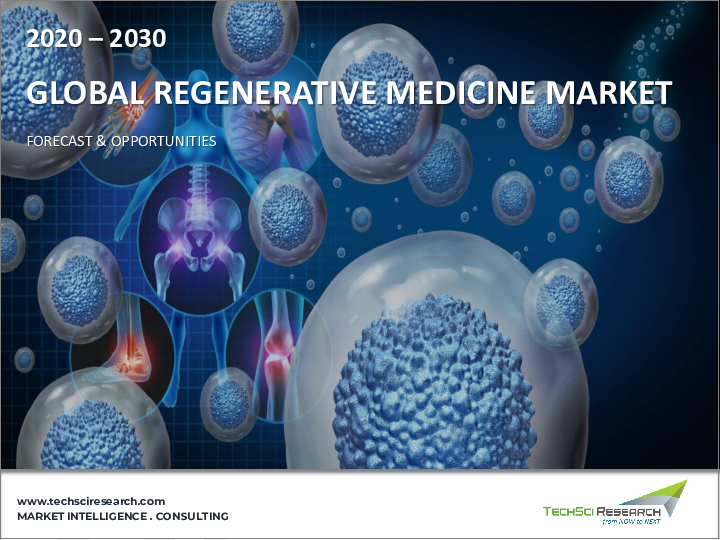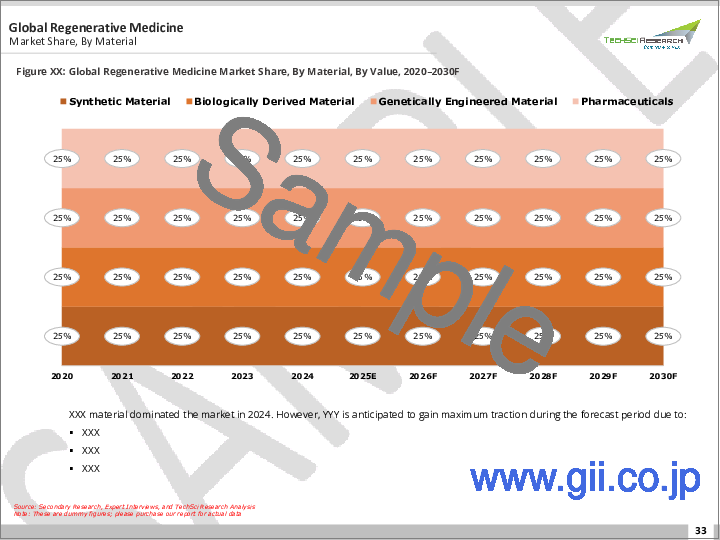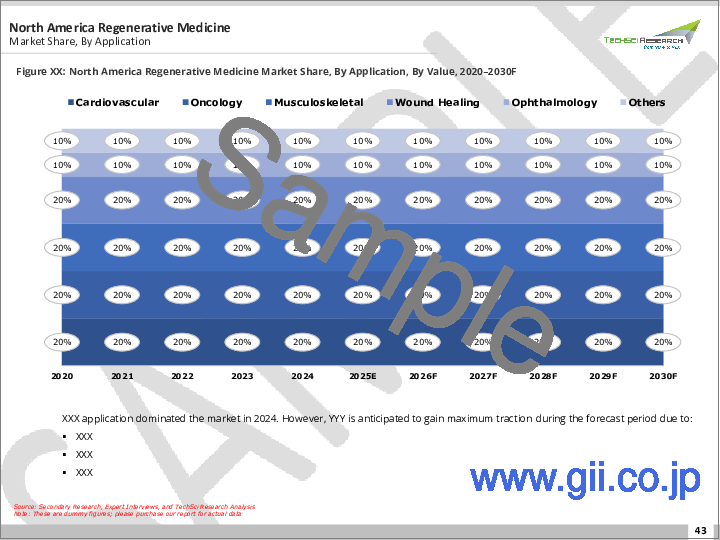|
|
市場調査レポート
商品コード
1785163
再生医療市場 - 世界の産業規模、シェア、動向、機会、予測:治療法別、材料別、用途別、エンドユーザー別、地域別、競合別、2020年~2030年Regenerative Medicine Market - Global Industry Size, Share, Trends, Opportunity, and Forecast, Segmented By Therapy, By Material, By Application, By End User, By Region and Competition, 2020-2030F |
||||||
カスタマイズ可能
|
|||||||
| 再生医療市場 - 世界の産業規模、シェア、動向、機会、予測:治療法別、材料別、用途別、エンドユーザー別、地域別、競合別、2020年~2030年 |
|
出版日: 2025年08月06日
発行: TechSci Research
ページ情報: 英文 180 Pages
納期: 2~3営業日
|
全表示
- 概要
- 目次
再生医療の世界市場規模は2024年に146億7,000万米ドルとなり、2030年までの予測期間のCAGRは9.45%で、目覚ましい成長が予測されています。
再生医療は、損傷したヒトの臓器や組織の置換や再生に焦点を当てた新たな分野です。この治療法では、幹細胞を利用して自然治癒が不可能な組織や臓器の機能を回復させる。
| 市場概要 | |
|---|---|
| 予測期間 | 2026-2030 |
| 市場規模:2024年 | 146億7,000万米ドル |
| 市場規模:2030年 | 250億2,000万米ドル |
| CAGR:2025年~2030年 | 9.45% |
| 急成長セグメント | 組織工学 |
| 最大市場 | 北米 |
例えば、米国がん協会の推計によると、2023年には米国で約195万8310人の新規がん患者と60万9820人のがん関連死亡者が報告され、市場の成長を牽引しています。科学者たちは、この治療法によって臓器や組織を実験室で増殖させ、人体に安全に移植できるようになると期待しています。再生医療の需要は、従来の治療と比較してより効果的な状態管理を提供する個別化治療アプローチにより急速に高まっています。再生医療は、人工臓器、細胞治療、組織工学など、さまざまな医療技術を包含しています。組織工学と生体材料は、新しい組織の形成を促進するために体内に移植される足場を用います。これらの足場は幹細胞を引き寄せ、望みの形をした組織の開発を促進します。細胞治療では、歯髄、脂肪、骨格筋、血液、骨髄などから採取した幹細胞を利用し、体内の損傷した組織を修復します。医療機器や人工臓器は、体内で機能不全に陥った臓器をサポートします。
主要市場促進要因
研究開発活動への投資の増加
主な市場課題
細胞・遺伝子治療用ベクターの信頼性の欠如
主要市場動向
新興国における潜在力の増加
目次
第1章 概要
第2章 調査手法
第3章 エグゼクティブサマリー
第4章 顧客の声
第5章 世界の再生医療市場展望
- 市場規模・予測
- 金額別
- 市場シェア・予測
- 治療法別(幹細胞療法、遺伝子療法、組織工学、小分子・生物学的製剤)
- 材料別(合成材料、生物由来材料、遺伝子組み換え材料、医薬品)
- 用途別(心臓血管、腫瘍学、筋骨格、創傷治癒、眼科など)
- エンドユーザー別(病院、専門センター、学術調査機関)
- 地域別
- 企業別(2024)
- 市場マップ
第6章 北米の再生医療市場展望
- 市場規模・予測
- 市場シェア・予測
- 北米:国別分析
- 米国
- カナダ
- メキシコ
第7章 欧州の再生医療市場展望
- 市場規模・予測
- 市場シェア・予測
- 欧州:国別分析
- ドイツ
- 英国
- イタリア
- フランス
- スペイン
第8章 アジア太平洋地域の再生医療市場展望
- 市場規模・予測
- 市場シェア・予測
- アジア太平洋地域:国別分析
- 中国
- インド
- 日本
- 韓国
- オーストラリア
第9章 南米の再生医療市場展望
- 市場規模・予測
- 市場シェア・予測
- 南米:国別分析
- ブラジル
- アルゼンチン
- コロンビア
第10章 中東・アフリカの再生医療市場展望
- 市場規模・予測
- 市場シェア・予測
- 中東・アフリカ:国別分析
- 南アフリカ
- サウジアラビア
- アラブ首長国連邦
第11章 市場力学
- 促進要因
- 課題
第12章 市場動向と発展
第13章 世界の再生医療市場:SWOT分析
第14章 競合情勢
- Stryker Corporation
- Athersys, Inc.
- Integra Lifesciences Corporation
- Isto Biologics(Isto Biologics Medical Systems, Inc.)
- Organogenesis Inc.
- CryoLife, Inc.
- Medtronic plc
- U.S. Stem Cell, Inc.
- Zimmer Biomet Holdings, Inc.
- 3M Company
第15章 戦略的提言
第16章 調査会社について・免責事項
Global Regenerative Medicine Market was valued at USD 14.67 Billion in 2024 and is anticipated to project impressive growth in the forecast period with a CAGR of 9.45% through 2030F. Regenerative medicine is an emerging discipline that focuses on the replacement or regeneration of damaged human organs or tissues. This therapeutic approach utilizes stem cells to restore function to tissues and organs that are unable to heal themselves.
| Market Overview | |
|---|---|
| Forecast Period | 2026-2030 |
| Market Size 2024 | USD 14.67 Billion |
| Market Size 2030 | USD 25.02 Billion |
| CAGR 2025-2030 | 9.45% |
| Fastest Growing Segment | Tissue Engineering |
| Largest Market | North America |
For instance, according to estimates from the American Cancer Society, approximately 1,958,310 new cancer cases and 609,820 cancer-related deaths were reported in the U.S. in 2023, driving growth in the market. Scientists anticipate that this therapy will enable the laboratory growth of organs and tissues, which can then be safely implanted into the human body. The demand for regenerative medicine is rapidly increasing due to its personalized treatment approach, which provides more effective management of conditions compared to conventional treatments. Regenerative medicine encompasses a range of medical techniques, including artificial organs, cellular therapies, and tissue engineering. Tissue engineering and biomaterials employ scaffolds that are implanted in the body to facilitate the formation of new tissue. These scaffolds attract stem cells, promoting the development of tissue with the desired shape. Cellular therapies utilize stem cells derived from dental pulp, fat, skeletal muscle, blood, bone marrow, and other sources to repair damaged tissues within the body. The medical devices and artificial organs offer support to failing organs within the body.
Key Market Drivers
Increasing Investments in R&D Activities
Increasing investments in research and development (R&D) activities have propelled market growth by driving innovative product launches. This surge in investments has led to comprehensive R&D initiatives, with numerous start-up companies receiving funding for the development of novel therapies and products. Consequently, this has facilitated significant collaborations, mergers, and partnerships aimed at maximizing the mutual benefits of R&D activities. In June 2022, Galapagos, a Belgian biotech company, announced its acquisition of Cell Point and Abound Bib. This strategic move aims to expedite the development and commercialization of next-generation cell therapies. With the integration of Cell Point and Abound Bio, Galapagos will gain access to innovative, scalable, decentralized, and automated point-of-care cell therapy supply models, as well as a cutting-edge fully human antibody-based therapeutics platform. Together, these advancements position Galapagos as a fully integrated biopharmaceutical company with the potential to disrupt the CAR-T treatment paradigm. Apart from private entities, various governments and government-funded research institutes are actively investing in this industry to introduce effective treatment options for chronic diseases like cancer, Parkinson's disease, diabetes, renal diseases, cardiovascular diseases, and others. In January 2022, the Royal College of Surgeons in Ireland secured USD 226,000 in funding from the European Commission for the development of antioxidant-ion substituted nanoparticles for osteoporotic bone treatment.
Key Market Challenges
Lack of Reliable Vector Production for Cell and Gene Therapy
Current methods of vector production often have limitations in terms of scalability. Producing enough high-quality vectors to meet the demands of clinical trials and potential commercialization can be challenging, especially for therapies with large patient populations. As regenerative medicine advances, the diversity of therapeutic approaches and vector types increases. Developing reliable vector production methods for various vectors, including adeno-associated viruses (AAVs) and lentiviruses, is crucial to accommodate this diversity.
Key Market Trends
Increase In Potential in Emerging Economies
Developing economies hold significant potential in the regenerative medicine market, driven by the rising prevalence of traumatic injuries and organ transplantations worldwide. Key industry players have strategically analyzed the opportunities in tissue engineering and regenerative medicine within these economies, leveraging various developmental strategies such as product launches, approvals, agreements, partnerships, and mergers. Despite ethical challenges arising from unfavorable norms, it is anticipated that developing economies will embrace tissue-engineering and regeneration technology.
Key Market Players
- Stryker Corporation
- Athersys, Inc.
- Integra Lifesciences Corporation
- Isto Biologics (Isto Biologics Medical Systems, Inc.)
- Organogenesis Inc.
- CryoLife, Inc.
- Medtronic plc
- U.S. Stem Cell, Inc.
- Zimmer Biomet Holdings, Inc.
- 3M Company
Report Scope:
In this report, the Global Regenerative Medicine Market has been segmented into the following categories, in addition to the industry trends which have also been detailed below:
Regenerative Medicine Market, By Therapy:
- Stem Cell Therapy
- Gene Therapy
- Tissue Engineering
- Small Molecule & Biologic
Regenerative Medicine Market, By Material:
- Synthetic Material
- Biologically Derived Material
- Genetically Engineered Material
- Pharmaceuticals
Regenerative Medicine Market, By Application:
- Cardiovascular
- Oncology
- Musculoskeletal
- Wound Healing
- Ophthalmology
- Others
Regenerative Medicine Market, By End User:
- Hospitals
- Specialty Centres
- Academic & Research Institutes
Regenerative Medicine Market, By Region:
- North America
- United States
- Canada
- Mexico
- Europe
- France
- United Kingdom
- Italy
- Germany
- Spain
- Asia-Pacific
- China
- India
- Japan
- Australia
- South Korea
- South America
- Brazil
- Argentina
- Colombia
- Middle East & Africa
- South Africa
- Saudi Arabia
- UAE
Competitive Landscape
Company Profiles: Detailed analysis of the major companies present in the Global Regenerative Medicine Market.
Available Customizations:
Global Regenerative Medicine market report with the given market data, TechSci Research offers customizations according to a company's specific needs. The following customization options are available for the report:
Company Information
- Detailed analysis and profiling of additional market players (up to five).
Table of Contents
1. Product Overview
- 1.1. Market Definition
- 1.2. Scope of the Market
- 1.2.1. Markets Covered
- 1.2.2. Years Considered for Study
- 1.2.3. Key Market Segmentations
2. Research Methodology
- 2.1. Objective of the Study
- 2.2. Baseline Methodology
- 2.3. Key Industry Partners
- 2.4. Major Association and Secondary Sources
- 2.5. Forecasting Methodology
- 2.6. Data Triangulation & Validations
- 2.7. Assumptions and Limitations
3. Executive Summary
- 3.1. Overview of the Market
- 3.2. Overview of Key Market Segmentations
- 3.3. Overview of Key Market Players
- 3.4. Overview of Key Regions/Countries
- 3.5. Overview of Market Drivers, Challenges, Trends
4. Voice of Customer
5. Global Regenerative Medicine Market Outlook
- 5.1. Market Size & Forecast
- 5.1.1. By Value
- 5.2. Market Share & Forecast
- 5.2.1. By Therapy (Stem Cell Therapy, Gene Therapy, Tissue Engineering, And Small Molecule & Biologic)
- 5.2.2. By Material (Synthetic Material, Biologically Derived Material, Genetically Engineered Material, And Pharmaceuticals)
- 5.2.3. By Application (Cardiovascular, Oncology, Musculoskeletal, Wound Healing, Ophthalmology, And Others)
- 5.2.4. By End User (Hospitals, Specialty Centres, Academic & Research Institutes)
- 5.2.5. By Region
- 5.2.6. By Company (2024)
- 5.3. Market Map
6. North America Regenerative Medicine Market Outlook
- 6.1. Market Size & Forecast
- 6.1.1. By Value
- 6.2. Market Share & Forecast
- 6.2.1. By Therapy
- 6.2.2. By Material
- 6.2.3. By Application
- 6.2.4. By End User
- 6.2.5. By Country
- 6.3. North America: Country Analysis
- 6.3.1. United States Regenerative Medicine Market Outlook
- 6.3.1.1. Market Size & Forecast
- 6.3.1.1.1. By Value
- 6.3.1.2. Market Share & Forecast
- 6.3.1.2.1. By Therapy
- 6.3.1.2.2. By Material
- 6.3.1.2.3. By Application
- 6.3.1.2.4. By End User
- 6.3.1.1. Market Size & Forecast
- 6.3.2. Canada Regenerative Medicine Market Outlook
- 6.3.2.1. Market Size & Forecast
- 6.3.2.1.1. By Value
- 6.3.2.2. Market Share & Forecast
- 6.3.2.2.1. By Therapy
- 6.3.2.2.2. By Material
- 6.3.2.2.3. By Application
- 6.3.2.2.4. By End User
- 6.3.2.1. Market Size & Forecast
- 6.3.3. Mexico Regenerative Medicine Market Outlook
- 6.3.3.1. Market Size & Forecast
- 6.3.3.1.1. By Value
- 6.3.3.2. Market Share & Forecast
- 6.3.3.2.1. By Therapy
- 6.3.3.2.2. By Material
- 6.3.3.2.3. By Application
- 6.3.3.2.4. By End User
- 6.3.3.1. Market Size & Forecast
- 6.3.1. United States Regenerative Medicine Market Outlook
7. Europe Regenerative Medicine Market Outlook
- 7.1. Market Size & Forecast
- 7.1.1. By Value
- 7.2. Market Share & Forecast
- 7.2.1. By Therapy
- 7.2.2. By Material
- 7.2.3. By Application
- 7.2.4. By End User
- 7.2.5. By Country
- 7.3. Europe: Country Analysis
- 7.3.1. Germany Regenerative Medicine Market Outlook
- 7.3.1.1. Market Size & Forecast
- 7.3.1.1.1. By Value
- 7.3.1.2. Market Share & Forecast
- 7.3.1.2.1. By Therapy
- 7.3.1.2.2. By Material
- 7.3.1.2.3. By Application
- 7.3.1.2.4. By End User
- 7.3.1.1. Market Size & Forecast
- 7.3.2. United Kingdom Regenerative Medicine Market Outlook
- 7.3.2.1. Market Size & Forecast
- 7.3.2.1.1. By Value
- 7.3.2.2. Market Share & Forecast
- 7.3.2.2.1. By Therapy
- 7.3.2.2.2. By Material
- 7.3.2.2.3. By Application
- 7.3.2.2.4. By End User
- 7.3.2.1. Market Size & Forecast
- 7.3.3. Italy Regenerative Medicine Market Outlook
- 7.3.3.1. Market Size & Forecast
- 7.3.3.1.1. By Value
- 7.3.3.2. Market Share & Forecasty
- 7.3.3.2.1. By Therapy
- 7.3.3.2.2. By Material
- 7.3.3.2.3. By Application
- 7.3.3.2.4. By End User
- 7.3.3.1. Market Size & Forecast
- 7.3.4. France Regenerative Medicine Market Outlook
- 7.3.4.1. Market Size & Forecast
- 7.3.4.1.1. By Value
- 7.3.4.2. Market Share & Forecast
- 7.3.4.2.1. By Therapy
- 7.3.4.2.2. By Material
- 7.3.4.2.3. By Application
- 7.3.4.2.4. By End User
- 7.3.4.1. Market Size & Forecast
- 7.3.5. Spain Regenerative Medicine Market Outlook
- 7.3.5.1. Market Size & Forecast
- 7.3.5.1.1. By Value
- 7.3.5.2. Market Share & Forecast
- 7.3.5.2.1. By Therapy
- 7.3.5.2.2. By Material
- 7.3.5.2.3. By Application
- 7.3.5.2.4. By End User
- 7.3.5.1. Market Size & Forecast
- 7.3.1. Germany Regenerative Medicine Market Outlook
8. Asia-Pacific Regenerative Medicine Market Outlook
- 8.1. Market Size & Forecast
- 8.1.1. By Value
- 8.2. Market Share & Forecast
- 8.2.1. By Therapy
- 8.2.2. By Material
- 8.2.3. By Application
- 8.2.4. By End User
- 8.2.5. By Country
- 8.3. Asia-Pacific: Country Analysis
- 8.3.1. China Regenerative Medicine Market Outlook
- 8.3.1.1. Market Size & Forecast
- 8.3.1.1.1. By Value
- 8.3.1.2. Market Share & Forecast
- 8.3.1.2.1. By Therapy
- 8.3.1.2.2. By Material
- 8.3.1.2.3. By Application
- 8.3.1.2.4. By End User
- 8.3.1.1. Market Size & Forecast
- 8.3.2. India Regenerative Medicine Market Outlook
- 8.3.2.1. Market Size & Forecast
- 8.3.2.1.1. By Value
- 8.3.2.2. Market Share & Forecast
- 8.3.2.2.1. By Therapy
- 8.3.2.2.2. By Material
- 8.3.2.2.3. By Application
- 8.3.2.2.4. By End User
- 8.3.2.1. Market Size & Forecast
- 8.3.3. Japan Regenerative Medicine Market Outlook
- 8.3.3.1. Market Size & Forecast
- 8.3.3.1.1. By Value
- 8.3.3.2. Market Share & Forecast
- 8.3.3.2.1. By Therapy
- 8.3.3.2.2. By Material
- 8.3.3.2.3. By Application
- 8.3.3.2.4. By End User
- 8.3.3.1. Market Size & Forecast
- 8.3.4. South Korea Regenerative Medicine Market Outlook
- 8.3.4.1. Market Size & Forecast
- 8.3.4.1.1. By Value
- 8.3.4.2. Market Share & Forecast
- 8.3.4.2.1. By Therapy
- 8.3.4.2.2. By Material
- 8.3.4.2.3. By Application
- 8.3.4.2.4. By End User
- 8.3.4.1. Market Size & Forecast
- 8.3.5. Australia Regenerative Medicine Market Outlook
- 8.3.5.1. Market Size & Forecast
- 8.3.5.1.1. By Value
- 8.3.5.2. Market Share & Forecast
- 8.3.5.2.1. By Therapy
- 8.3.5.2.2. By Material
- 8.3.5.2.3. By Application
- 8.3.5.2.4. By End User
- 8.3.5.1. Market Size & Forecast
- 8.3.1. China Regenerative Medicine Market Outlook
9. South America Regenerative Medicine Market Outlook
- 9.1. Market Size & Forecast
- 9.1.1. By Value
- 9.2. Market Share & Forecast
- 9.2.1. By Therapy
- 9.2.2. By Material
- 9.2.3. By Application
- 9.2.4. By End User
- 9.2.5. By Country
- 9.3. South America: Country Analysis
- 9.3.1. Brazil Regenerative Medicine Market Outlook
- 9.3.1.1. Market Size & Forecast
- 9.3.1.1.1. By Value
- 9.3.1.2. Market Share & Forecast
- 9.3.1.2.1. By Therapy
- 9.3.1.2.2. By Material
- 9.3.1.2.3. By Application
- 9.3.1.2.4. By End User
- 9.3.1.1. Market Size & Forecast
- 9.3.2. Argentina Regenerative Medicine Market Outlook
- 9.3.2.1. Market Size & Forecast
- 9.3.2.1.1. By Value
- 9.3.2.2. Market Share & Forecast
- 9.3.2.2.1. By Therapy
- 9.3.2.2.2. By Material
- 9.3.2.2.3. By Application
- 9.3.2.2.4. By End User
- 9.3.2.1. Market Size & Forecast
- 9.3.3. Colombia Regenerative Medicine Market Outlook
- 9.3.3.1. Market Size & Forecast
- 9.3.3.1.1. By Value
- 9.3.3.2. Market Share & Forecast
- 9.3.3.2.1. By Therapy
- 9.3.3.2.2. By Material
- 9.3.3.2.3. By Application
- 9.3.3.2.4. By End User
- 9.3.3.1. Market Size & Forecast
- 9.3.1. Brazil Regenerative Medicine Market Outlook
10. Middle East and Africa Regenerative Medicine Market Outlook
- 10.1. Market Size & Forecast
- 10.1.1. By Value
- 10.2. Market Share & Forecast
- 10.2.1. By Therapy
- 10.2.2. By Material
- 10.2.3. By Application
- 10.2.4. By End User
- 10.2.5. By Country
- 10.3. MEA: Country Analysis
- 10.3.1. South Africa Regenerative Medicine Market Outlook
- 10.3.1.1. Market Size & Forecast
- 10.3.1.1.1. By Value
- 10.3.1.2. Market Share & Forecast
- 10.3.1.2.1. By Therapy
- 10.3.1.2.2. By Material
- 10.3.1.2.3. By Application
- 10.3.1.2.4. By End User
- 10.3.1.1. Market Size & Forecast
- 10.3.2. Saudi Arabia Regenerative Medicine Market Outlook
- 10.3.2.1. Market Size & Forecast
- 10.3.2.1.1. By Value
- 10.3.2.2. Market Share & Forecast
- 10.3.2.2.1. By Therapy
- 10.3.2.2.2. By Material
- 10.3.2.2.3. By Application
- 10.3.2.2.4. By End User
- 10.3.2.1. Market Size & Forecast
- 10.3.3. UAE Regenerative Medicine Market Outlook
- 10.3.3.1. Market Size & Forecast
- 10.3.3.1.1. By Value
- 10.3.3.2. Market Share & Forecast
- 10.3.3.2.1. By Therapy
- 10.3.3.2.2. By Material
- 10.3.3.2.3. By Application
- 10.3.3.2.4. By End User
- 10.3.3.1. Market Size & Forecast
- 10.3.1. South Africa Regenerative Medicine Market Outlook
11. Market Dynamics
- 11.1. Drivers
- 11.2. Challenges
12. Market Trends & Developments
13. Global Regenerative Medicine Market: SWOT Analysis
14. Competitive Landscape
- 14.1. Stryker Corporation
- 14.2. Athersys, Inc.
- 14.3. Integra Lifesciences Corporation
- 14.4. Isto Biologics (Isto Biologics Medical Systems, Inc.)
- 14.5. Organogenesis Inc.
- 14.6. CryoLife, Inc.
- 14.7. Medtronic plc
- 14.8. U.S. Stem Cell, Inc.
- 14.9. Zimmer Biomet Holdings, Inc.
- 14.10. 3M Company





